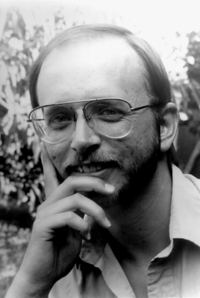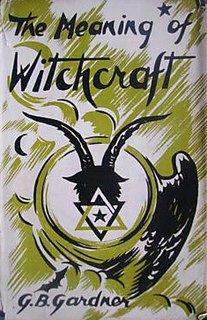
Dianic Wicca, also known as Dianic Witchcraft, is a neopagan religion female-centered goddess ritual and tradition. While some adherents identify as Wiccan, it differs from most traditions of Wicca in that only goddesses are honored.

Wicca, also termed Pagan Witchcraft, is a modern Pagan religion. Scholars of religion categorise it as both a new religious movement and as part of the occultist stream of Western esotericism. It was developed in England during the first half of the 20th century and was introduced to the public in 1954 by Gerald Gardner, a retired British civil servant. Wicca draws upon a diverse set of ancient pagan and 20th-century hermetic motifs for its theological structure and ritual practices.
A coven usually refers to a group or gathering of witches. The word "coven" remained largely unused in English until 1921 when Margaret Murray promoted the idea that all witches across Europe met in groups of thirteen which they called "covens".

A Book of Shadows is a book containing religious text and instructions for magical rituals found within the Neopagan religion of Wicca, and in many pagan practices. One famous Book of Shadows was created by the pioneering Wiccan Gerald Gardner sometime in the late 1940s or early 1950s, and which he utilised first in his Bricket Wood coven and then in other covens which he founded in following decades. The Book of Shadows is also used by other Wiccan traditions, such as Alexandrianism and Mohsianism, and with the rise of books teaching people how to begin following Wicca in the 1970s onward, the idea of the Book of Shadows was then further propagated amongst solitary practitioners unconnected to earlier traditions.

A wand is a thin, light-weight rod that is held with one hand, and is traditionally made of wood, but may also be made of other materials, such as metal or plastic. A wand that is used for magical purposes is often called a magic wand, rather than simply a wand. Wands are distinct from scepters, which have a greater thickness, are held differently, and have a relatively large top ornament on them.

Scott Douglas Cunningham was a U.S. writer. Cunningham is the author of several books on Wicca and various other alternative religious subjects.

A magic circle is a circle of space marked out by practitioners of some branches of ritual magic, which they generally believe will contain energy and form a sacred space, or will provide them a form of magical protection, or both. It may be marked physically, drawn in a material like salt or chalk, or merely visualised.
Celtic Wicca is a modern tradition of Wicca that incorporates some elements of Celtic mythology. It employs the same basic theology, rituals and beliefs as most other forms of Wicca. Celtic Wiccans use the names of Celtic deities, mythological figures, and seasonal festivals within a Wiccan ritual structure and belief system, rather than a traditional or historically Celtic one.

Janet Farrar is a British teacher and author of books on Wicca and Neopaganism. Along with her two husbands, Stewart Farrar and Gavin Bone, she has published "some of the most influential books on modern Witchcraft to date". According to George Knowles, "some seventy five percent of Wiccans both in the Republic and Northern Ireland can trace their roots back to the Farrars."

The Church and School of Wicca was founded by Gavin Frost and Yvonne Frost in 1968. It was the first federally recognized Church of the religion known as Wicca in the United States. It is well known for its correspondence courses on the Frosts' unique interpretation of Wicca. The Church and School are located in Beckley, West Virginia.
The history of Wicca documents the rise of the Neopagan religion of Wicca and related witchcraft-based Neopagan religions. Wicca originated in the early twentieth century, when it developed amongst secretive covens in England who were basing their religious beliefs and practices upon what they read of the historical Witch-Cult in the works of such writers as Margaret Murray. It was subsequently popularized in the 1950s by a number of figures, in particular Gerald Gardner, who claimed to have been initiated into the Craft – as Wicca is often known – by the New Forest coven in 1939. Gardner's form of Wicca, the Gardnerian tradition, was spread by both him and his followers like the High Priestesses Doreen Valiente, Patricia Crowther and Eleanor Bone into other parts of the British Isles, and also into other, predominantly English-speaking, countries across the world. In the 1960s, new figures arose in Britain who popularized their own forms of the religion, including Robert Cochrane, Sybil Leek and Alex Sanders, and organizations began to be formed to propagate it, such as the Witchcraft Research Association. It was during this decade that the faith was transported to the United States, where it was further adapted into new traditions such as Feri, 1734 and Dianic Wicca in the ensuing decades, and where organizations such as the Covenant of the Goddess were formed.

Wiccan views of divinity are generally theistic, and revolve around a Goddess and a Horned God, thereby being generally dualistic. In traditional Wicca, as expressed in the writings of Gerald Gardner and Doreen Valiente, the emphasis is on the theme of divine gender polarity, and the God and Goddess are regarded as equal and opposite divine cosmic forces. In some newer forms of Wicca, such as feminist or Dianic Wicca, the Goddess is given primacy or even exclusivity. In some forms of traditional witchcraft that share a similar duotheistic theology, the Horned God is given precedence over the Goddess.

In the neopagan religion of Wicca, a range of magical tools are used in ritual practice. Each of these tools has different uses and associations, and serve primarily to direct magical energies. They are used at an altar, inside a magic circle.
Chas S. Clifton is an American academic, author and historian who specialises in the fields of English studies and Pagan studies. Clifton currently holds a teaching position in English at Colorado State University-Pueblo, prior to which he taught at Pueblo Community College.

Vivianne Crowley is an author, university lecturer, psychologist, and a High Priestess and teacher of the Wiccan religion. She was initiated into the London coven of Alex Sanders at the age of eighteen, but later joined a Gardnerian coven in the famous Whitecroft line derived from Eleanor Bone, and so she was one of few people in the seventies to be part of both traditions.
Georgian Wicca is a tradition, or denomination, in the neopagan religion of Wicca. In its organisation, it is very similar to British Traditional Wicca groups such as Gardnerian Wicca, however, it does not trace its initiatory line to one of the old English covens.

The Meaning of Witchcraft is a non-fiction book written by Gerald Gardner. Gardner, known to many in the modern sense as the "Father of Wicca", based the book around his experiences with the religion of Wicca and the New Forest Coven. It was first published in 1959, only after the British Parliament repealed the Witchcraft Act of 1735, and proved to be Gardner's final book. The Wicca religion as expounded by Gardner was focused on a goddess, identified with the night sky and with wild nature, and a horned god who represented the fertilizing powers of the natural world. It was organized into covens, through which members were initiated through three ascending degrees of competence and authority and which were governed by a high priestess, supported by a high priest. More historical context to the pagan practice of Wicca can be found in the book Wicca: History, Belief, and Community in Modern Pagan Witchcraft That book discusses Wiccan life, covering how and why people convert to Wicca; its denominations; its sociological demographics; its political beliefs, particularly in terms of environmentalist issues; the impact of anti-Wiccan persecution; the transmission of Wiccan and Pagan culture; and the history of academic analysis of Wicca.
In Modern English, the term Wicca refers to Wicca, the religion of contemporary Pagan Witchcraft. It is used within the Pagan community under competing definitions. One refers to the entirety of the Pagan Witchcraft movement, while the other refers explicitly to traditions included in what is now called British Traditional Wicca.

A Community of Witches: Contemporary Neo-Paganism and Witchcraft in the United States is a sociological study of the Wiccan and wider Pagan community in the Northeastern United States. It was written by American sociologist Helen A. Berger of the West Chester University of Pennsylvania and first published in 1999 by the University of South Carolina Press. It was released as a part of a series of academic books entitled Studies in Comparative Religion, edited by Frederick M. Denny, a religious studies scholar at the University of Chicago.











